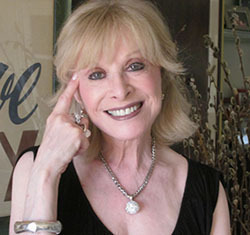Part 1: Making of “The Last Five Years”
“The Fisher King” starring Robin Williams and Jeff Bridges was Richard LaGravenese’s break-out script launching him on the road to success as a Hollywood screenwriter.
Ask the average movie goer if he or she knows who Richard LaGravenese is. The answer is probably going to be no. In the same sentence add that he wrote “Behind the Candelabra,” “Water for Elephants,” “P.S. I Love You,” “Freedom Writers,” “Paris, je t’aime,” “Beloved,” “The Horse Whisperer,” “The Mirror Has Two Faces,” “The Bridges of Madison County,” “A Little Princess,” “The Ref,” “Erin Brockovich,” “The Fisher King,” and “Rude Awakening.” Then, of course, the light goes on.
LaGravenese’s body of work is immediately recognizable considering that the Academy Award-nominated writer penned some of Hollywood’s most emotionally profound scripts.
LaGravenese’s latest film is “The Last Five Years” (released last month in theaters). Originally a musical written for the New York stage by Jason Robert Brown, LaGravenese adapted and directed the material for his screen version. The film stars Anna Kendrick in the lead role of Cathy with Jeremy Jordan as her husband Jamie. The narrative, which is told through songs, deconstructs the hills and valleys of the couple’s disintegrating marriage, each of who tells the story from a different starting and ending point.
Mr. LaGravenese recently sat down for an exclusive interview to discuss, among other personal topics, his latest film.
Among your vast list of screenwriting credits, you wrote two of my all-time favorite films – “Bridges of Madison County” and “Horse Whisperer.” All your characters are so fully fleshed out. There’s never a “cardboard” moment and that’s your signature. You write fabulous characters. LaGravenesse: Thank you. That’s so nice to hear.
“The Last Five Years” was performed off-Broadway in New York. Did you see the stage version? I didn’t see the original production, which was in 2002, but I did see the last one in April of 2013, which was the revival that Jason Robert Brown directed. I had already written the screenplay by then and we started shooting in June.
How did you originally become familiar with the score? My friend Todd Graff directed a movie called Camp, which is the reason I wanted Anna because she was in Camp. He and I are best buddies and go to theatre all the time. I kept hearing about this score, but I had missed the show so he gave it to me.
Since you had written the screenplay before you saw the play, what attracted you to the story originally? I heard the score and being a musical theatre fan, all I need is the score to fall in love with a musical. There are many musicals that I’ve never seen but loved just because I heard the score. In the early part of the turn of the century, around 2004 or 2005, as I mentioned, I got the score and listened to it over and over. I fell in love with it and started to imagine it a small, independent, little jewel of a movie.
How did it finally morph into a film? In 2006, I was doing a movie called P.S. I Love You, and Sherie Rene Scott who played Cathy in the original production came in to audition and the first thing I said was, ‘Oh my God. That’s from The Last Five Years. I told her my idea and her then husband Kurt Deutsch had a company that makes original cast recordings for Broadway shows and they did the original album. I met him, loved the idea of doing this and then Kurt introduced me to Jason. It was not your usual idea of doing this kind of musical as a film, but Jason very graciously let me play with it. Over the years, I kept working on it with him and alone. I wanted to do it outside of the system. I didn’t want any studio involvement. I didn’t want to be told that I had to impose anything on it. I wanted to have the freedom to do it for a very small budget and to do it the way I wanted to. I knew being a musical theatre purist, I wanted to keep the show in its original form as much as possible, which was a risk, and I knew it was a risk, and the only way you can take a risk, is to do something inexpensively.
Did your script differ a lot from Brown’s original script? Script-wise no. It’s all Brown’s music and structurally it’s entirely his show in that all of Cathy’s songs start at the end and go to the beginning, and all of Jamie’s songs start at the beginning and go to the end. The biggest difference is that on stage it’s done as monologues. They do not sing to each other. They sing to the audience. They only sing to each other when he proposes during a song called “The Next Ten Minutes.” My idea was to have them sing to each other when it was appropriate because then it became a playable scene and dramatically it was really interesting because it wasn’t just a person’s point of view who was singing the song, but it was also how you were hearing it – the effect it has on you and how men and women, although they love each other, can be singing different songs to each other and never really understand the meaning.
The idea of shooting the film in this way was a slippery slope as it could have been boring. However, Steven Meizler’s cinematography is stunning and the film is never boring. How did you decide the look of the film to avoid that pitfall? I wanted the pacing to be organic. It isn’t about a lot of cuts being thrown at you. I wanted it to take its time and breathe.
Anna Kendrick as Cathy and Jeremy Jordan as Jamie, the troubled couple in “The Last Five Years,” a film adapted and directed by Richard LaGravenese from Jason Robert Brown’s musical. Courtesy photo.
When you were writing, did you have Anna in mind? You have to understand while I was working on this, I never thought it was going to actually happen. This was just something I was doing in my spare time for myself, but then when it did become a reality, yes, Anna was my first choice. Generally, I tend not to write with specific actors in mind because it blocks my writing. But again, I didn’t write this. Except for little bits of dialogue I wrote here and there, the content is all Jason’s.
How did you find Jeremy? He auditioned. I saw him in Joyful Noise and in the television series Smash. It was very important that I had actors who could sing. I didn’t want actors who were good actors but worried about their voices. Because the parts are so emotional, and the characters go through so much, I wanted the actors to be very confident that they could perform. So the singing had to be second nature to them and for Anna and Jeremy, it is. Jeremy auditioned with the song; “If I Didn’t Believe In You.” I knew that if he could do that song, he could do the rest of the movie because that song is like a little one-act play. He starts off very supportive and loving towards his wife and then he winds up being very cruel and angry.
How long was the shoot and how did you set each scene with the actors? We shot the movie in 21 days from June to July in 2013. In April, I had them for five days and that was the first time they met. I had my cinematographer with his camera and a piano player in an empty room with blocks. We went over every song. I had specific staging. I had very specific ideas and certain things came out of rehearsals like doing “If I Didn’t Believe You,” which was sung in one take. I said to them, ‘Improvise the argument and then just go wherever you want and Steven will follow you.’ When Steven and I looked at the rehearsal footage, we designed the movie based on that footage. I would work with the actors on set who always had terrific ideas and were very collaborative.
Did the script change in any way during the shoot? No, just locations and certain ideas. I remember I wanted a helicopter shot and that was going to be too expensive. So then it became putting the camera in the back seat of the car over the Verrazano Bridge.
Many of the scenes are very emotional. Did the actors have time to decompress? Yes, but you don’t want too much decompression because you want to keep it going and get more. For me, you hold your breath because of camera angles and because of the performances. Then you get that click like, ‘oh I got it!’ Then I would a say to them, ‘I feel like I have it; now do just for you. Do what you want’ and often, wonderful things would come out of that because they were relaxed and had freedom knowing that I’ve gotten the take and that I’m pleased. That’s pretty how much it worked. I would get so emotionally involved that they could hear, oh my God,’ after I said ‘cut.’ They would look at each other and say ‘Richard liked it.’ I would literally say cut through tears because I was so emotionally involved with it.
That’s why your work is so wonderful. That’s because I’m a nerd.
In this film you are the adapter and director. What’s the big advantage of wearing both hats and is there a disadvantage? The most wonderful advantage about this project is that I didn’t write the material. I was just adapting it into film. I had so much confidence in it and loved it so much. I had the freedom just to direct and I’d never had that experience before. When I’m doing both, because I’m primarily a writer, I worry about the script. I’m always second guessing the script and not believing in it and I don’t have as much confidence. So with this, I had total confidence in the material and that was very liberating.
When I interviewed Woody Allen, he said that he writes notes on little scraps of paper and puts them in a drawer and once a year he goes through all the notes. How do you keep track of your ideas? I have little journals. I wish I more organized like him – like having a drawer – but they’re kind of all over the place and I go through them, which is what I’m doing right now. I’m going to be writing an original script so I’m looking at all my ideas in bits and pieces. Sometimes you start with an idea for a scene or sometimes it’s a concept for a story. You have to have the discipline to write down your ideas because as I’ve gotten older I think I’ll remember this idea, but you don’t. It’s terrible.
Stay tuned for Part 2, which will cover the movies and plays that influenced his childhood, how he got started writing, and the huge role his wife has played in his success. 



No comments yet.